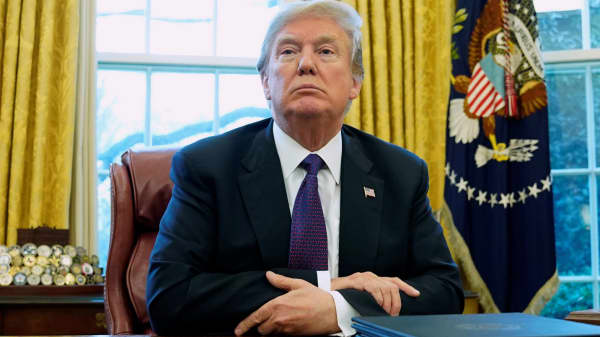There are two obvious ways to play this: (1) China could buy more U.S. goods and services, and/or (2) America could buy fewer Chinese goods and services. Both come with drawbacks for the U.S. economy and the American people. It is hard for U.S. companies to ramp up to export more to China when they are operating at full capacity and have close to no unemployment.
But before evaluating the policy prescriptions for this problem, we must first consider the starting point, which is flawed. The current $370 billion deficit estimate does not account for value-added. When looking at the value-added content of Chinese exports, the U.S. deficit with China is actually only half of what it seems. And if we then add back the U.S. surplus in "invisibles" and how much money the United States brings back from investments in China, the U.S.–China deficit shrinks from 2 percent of U.S. GDP to 0.8 percent, a report from Oxford Economics revealed.
More from Global Investing Hot Spots:
China determined to steal A.I. crown from US
Trade war with US could be a tipping point for China
In the case of the Apple iPhone, this means that China's exports balance accounts for the full $500 iPhone value, when China adds only approximately $15 to $30 of the value to the phone. Most of the iPhone value accretes to Samsung in Korea ($150) and to Apple — the brand owner and engineer. This highlights how the normal accounting of trade flows is inherently distorted under the current trade-deficit estimates. So maybe the deck has only 25 not 52 cards.
The iPhone example also points to an area of weakness in the president's policy prescription: If the United States introduces tariffs on China's high-tech goods, U.S. companies and consumers could indirectly end up footing part of the bill. This is because the high-tech industries that Trump's tariffs are focused on is where Chinese value-added has the lowest share. If Trump were really interested in impacting the true trade imbalance and not just the misleading headline estimate, he would introduce tariffs on those sectors where China's value-added is highest. This would include sectors like textiles, where 75 percent of value-added is really "made in China."
This brings us back to the president's other objective, which is to gain political credit by addressing historical areas of imbalance in the U.S.–China trade relationship. A key area of focus here is China's appropriation of the intellectual property (IP) of American businesses. This comes from three activities: corporate espionage, cybertheft and technology in exchange for market access.
The latter results from a longstanding Chinese policy that requires any foreign company wishing to do business in China to first form a joint venture with a Chinese firm. A common complaint about these joint ventures is that they open the door for Chinese companies potentially to steal trade secrets and then use that IP to build and grow Chinese industries in everything from cars and phones to medicine.
The U.S. government estimates that these alleged IP appropriations, along with direct corporate espionage, which go back as far as the 1990s, have cost the U.S. economy a lot, somewhere between $225 billion to $600 billion a year. China indeed appears to have been the better poker player.
While these are valid concerns that should be addressed, it's too little too late. The truth is, China no longer needs these joint-venture rules in many industries, with several sectors and companies already competitive with their counterparts in the United States. In fact, in April 2018 China agreed to ease its rules on foreign auto companies operating in China, a clear signal that the quality of Chinese cars, including autonomous and electric vehicles, is rapidly increasing. It also just announced that foreigners would no longer need specific permissions to invest; they would just be prohibited from investing in a "negative list" of industries.











